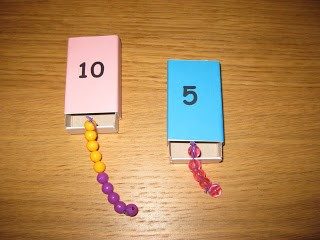How to play?
The worm in the box exercises the ability to divide numbers. The game starts with the teacher and the children investigating how many beads make up the worm’s body. Count the beads in different ways, both backwards and forwards. The teacher takes out the matchbox and tells them that this is the worm’s house. It is important to draw the children’s attention to the number on the house and link it to the number of beads on the worm. The teacher explains and demonstrates that the worm crawls into the house and hides and then the house closes. Ask the children: how many beads of the worm’s body are inside the house? How do you know? How many are outside the house? Open the house and see how many there are.

What is the purpose of the game?
The purpose of the worm in the box is to practice the ability to divide numbers. It is a concrete and clear way to make addition and subtraction visible to the children. In order to understand the relationship between parts and whole, it is important that the whole is discernible. The worm in the box helps children to practise the ability to automate the division of numbers.
How to make the game?
I have used small matchboxes which I have lined with coloured paper with a number on it. This becomes the worm’s house. I made the worm itself by stringing beads on a thread and tying the ends of the thread. How many beads you need depends on the number you want to practice with the children. My suggestion is to make nine worms with corresponding houses, with numbers two to ten to practice different numbers.
The idea is taken from Mattelekar i förskolan
